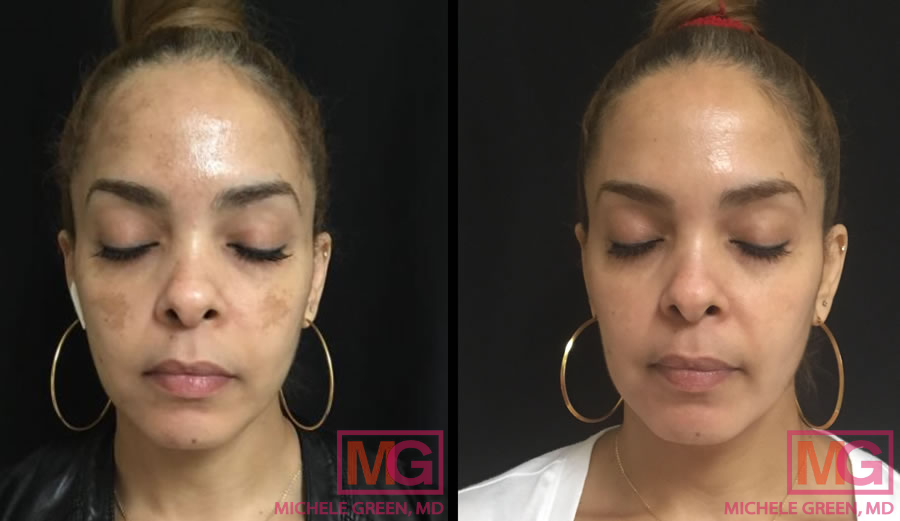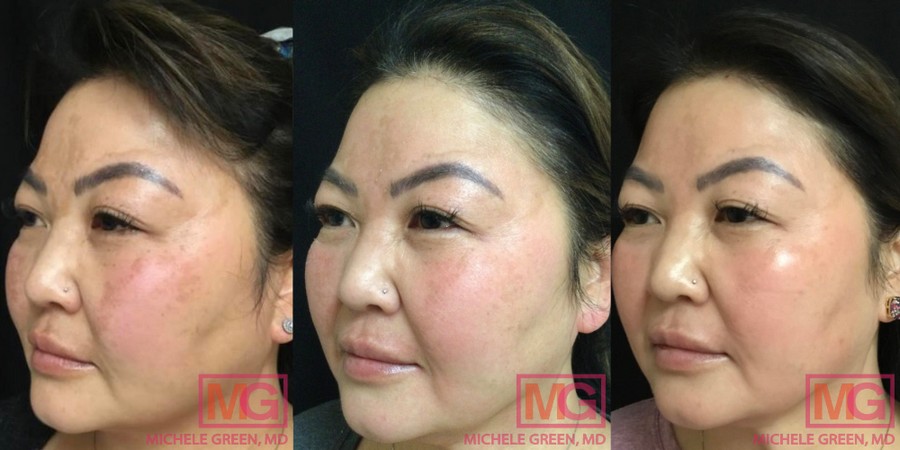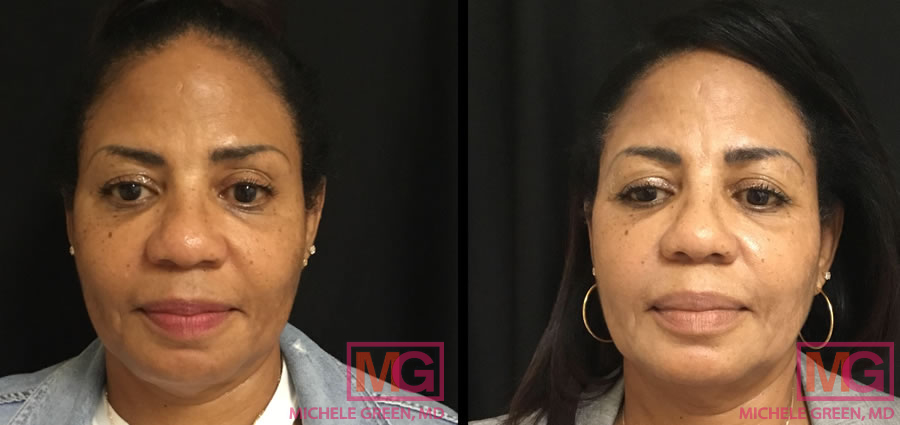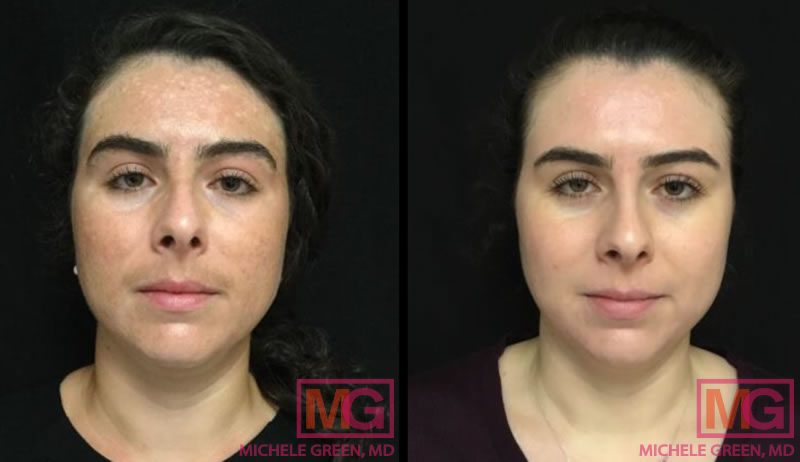Melasma Laser Treatment
Melasma is a common skin condition characterized by brown or gray-brown patches, typically appearing on the upper lip, cheeks, bridge of the nose, and forehead. It develops from the overproduction of melanin in the skin’s pigmented cells. Various risk factors, including sun exposure, hormonal changes, pregnancy, thyroid disease, and family history, can trigger melasma. Although melasma is not curable, it can be treated with non-invasive cosmetic procedures and prevented with specific skincare products and lifestyle choices. Treating melasma can be particularly challenging, as some treatments that typically work for other forms of hyperpigmentation may actually worsen the condition. It is essential to consult with an expert dermatologist, like Dr. Michele Green in New York City, for your melasma treatment. With over 25 years of experience in treating this condition, Dr. Green employs cutting-edge treatments to reduce pigmentation and achieve clear, radiant skin.
While lasers are an excellent treatment option for addressing fine lines, skin laxity, and sunspots, they are not the first choice for treating melasma. Chemical peels like the Cosmelan peel are often used to enhance skin cell turnover and correct pigmentation caused by melasma. Topical skin-lightening ingredients, including hydroquinone, tranexamic acid, kojic acid, vitamin C, glycolic acid, and tretinoin, are highly effective in gradually reducing the appearance of melasma. In addition to chemical peels and targeted skincare products, many patients wonder how to treat melasma with lasers, including IPL or Pico lasers. Melasma laser treatment should always be approached cautiously, as studies have shown that laser therapy can worsen melasma, especially in patients with darker skin types. It is essential to consult a board-certified dermatologist, such as Dr. Green, before undergoing any melasma treatment to ensure that the treatment is safe and effective for your specific skin type and tone.
Expert board-certified cosmetic dermatologist Dr. Michele Green has treated patients with melasma in her Upper East Side dermatology office in New York City for over two and a half decades. Dr. Green has been recognized as one of New York City’s best dermatologists by publications such as Castle Connolly, Super Doctors, New York Magazine, and The New York Times due to her expertise and high patient satisfaction. With her exclusive range of skincare products, MGSKINLABs, Dr. Green specializes in providing patients with personalized treatment plans tailored to their skin type and aesthetic goals. When you consult with Dr. Green, she will choose the procedures and skincare products best suited to manage and prevent your melasma.
What is melasma?
Melasma is a skin condition characterized by brown, dark brown, or gray-brown patches affecting the face, chest, and neck. It is most common in women, with only 10% of all melasma cases attributed to men. The condition is also more prevalent among patients with darker skin tones, as well as those of East Asian, Indian, Hispanic, Middle Eastern, and Mediterranean descent, due to their already high prevalence of melanin and melanocytes in the skin. The pigmentation from melasma is not associated with any discomfort, itchiness, or increased risk of skin cancer. This pigmentation often appears in highly visible areas such as the forehead, upper lip, bridge of the nose, and cheeks, prompting many patients to seek cosmetic treatment. Three main types of melasma may occur: epidermal melasma, which appears in the superficial layer of skin known as the epidermis; dermal melasma, which is located in the middle layer of the skin known as the dermis; and mixed melasma, which occurs when there is a combination of epidermal and dermal melasma.
What causes melasma?
Melasma occurs due to an overproduction of melanin in melanocytes, the skin cells responsible for melanin production. While the exact underlying cause of melasma is unknown, many patients with the condition have a family history of it. Hormonal changes, particularly surges in the female hormones estrogen and progesterone, can trigger melasma. Women are most commonly affected by this skin condition because of hormonal fluctuations associated with contraceptive treatments, pregnancy, and hormone replacement therapy. Additionally, thyroid disorders may be related to melasma, as the incidence of thyroid disease is nearly four times that of the general population.

What are the best treatment options for melasma?
Melasma treatment can be challenging, and many traditional methods for treating hyperpigmentation on the skin’s surface can worsen it. Each case of melasma is different, and the best treatment option or combination of treatments will vary from patient to patient. The most effective in-office treatments for melasma are typically chemical peels, as they increase skin cell turnover to enhance skin tone and texture while reducing the appearance of pigmentation. Topical treatments, including hydroquinone, kojic acid, tretinoin, vitamin C, and azelaic acid, are excellent for gradually diminishing pigmentation and improving the results of chemical peels or other cosmetic procedures. While some laser treatments claim to treat melasma, many laser therapies can actually worsen or exacerbate its appearance. When choosing a melasma treatment option, it is essential to consult with a board-certified dermatologist, such as Dr. Green, who can develop a personalized treatment plan that will safely and effectively address your melasma.
Can chemical peels treat melasma?
Chemical peels are popular cosmetic procedures that address various skin concerns, including melasma. They are effective treatment options for reducing the appearance of melasma. Chemical peels involve applying a chemical exfoliant or compound to the skin, removing dead, pigmented cells and revealing healthier, brighter cells at the surface. The formulation and strength of chemical peels can vary, and they may not be suitable for all skin types and tones. The downtime following the treatment session depends on the strength of the peel. In the days and weeks that follow the treatment, patients will notice improved results from the chemical peel. For many chemical peels, a series of treatment sessions is often required to achieve optimal results. Dr. Green frequently incorporates targeted skin-lightening ingredients into a chemical peel treatment plan to enhance exfoliation and improve the treatment results.
Cosmelan Peel for melasma and pigmentation
The Cosmelan peel is a specialized, two-step medical-grade chemical peel that effectively treats melasma, hyperpigmentation, and skin discoloration. By inhibiting tyrosinase, an enzyme responsible for producing melanin in the skin, the Cosmelan peel reduces the formation and accumulation of new melanin. The first step of the Cosmelan peel involves a qualified expert, such as board-certified dermatologist Dr. Green, applying the Cosmelan 1 mask to hyperpigmented areas. The mask is left on for a duration determined by Dr. Green based on your skin type and tone. After the designated time, the mask is removed at home using a gentle cleanser. The second step of the Cosmelan peel requires following a specific skincare routine with targeted products to lighten the skin further. The Cosmelan peel is an excellent option for treating melasma in patients of all skin types and tones, including those with darker skin tones who may not be suitable candidates for other types of chemical peels. It is crucial to practice strict sun avoidance during the Cosmelan peel process to prevent a recurrence of melasma. Throughout the treatment, Dr. Green will review and adjust your skincare products to help you maintain and enhance the results from the peel.
Which topical skin care ingredients are most effective for melasma?
Topical treatments are typically the first line of defense against melasma and are often recommended after laser therapies. Some products and ingredients can be obtained over-the-counter (OTC), while others necessitate a prescription from a dermatologist. The most effective ingredients for topical melasma treatment are as follows:
Hydroquinone is a prescription-only skin-lightening ingredient. It is commonly found in skin-lightening and bleaching products and is not meant for long-term use. Extended use of hydroquinone may lead to ochronosis, a condition that worsens hyperpigmentation. Dr. Green may prescribe cysteamine or tranexamic acid as bleach-free alternatives to hydroquinone.
Tretinoin is a topical retinoid, also known as Retin-A, derived from vitamin A that Dr. Green may prescribe to reduce hyperpigmented areas. When applied to the skin’s surface, tretinoin helps to increase skin cell turnover, boosts collagen production, and diminishes signs of hyperpigmentation. Patients with sensitive skin may experience dryness and irritation from Retin-A. If this occurs, Dr. Green often recommends switching to an over-the-counter retinol product.
Patients who find hydroquinone or tretinoin irritating can opt for gentle skin-lightening products such as kojic acid, tranexamic acid, and azelaic acid. The Skin Brightening Cream from MGSKINLABs features a unique blend of kojic acid and fruit extracts to brighten the skin and reduce melasma.
Vitamin C serum is one of the best antioxidant topical treatments for hyperpigmentation. It is a powerful antioxidant that promotes collagen production and skin cell renewal, reducing hyperpigmentation and dark spots in the outer layer of the skin while neutralizing the harmful effects of free radicals. Dr. Green’s very own MGSKINLABs sells a Vita-C Serum containing a high concentration of vitamin C to brighten and rejuvenate the skin.
UVA and UVB rays from the sun are common triggers for melasma, making sunscreen the most critical topical product for preventing and reducing it. For patients with a history of melasma, Dr. Green recommends applying a broad-spectrum SPF of 50 or higher every day, even on cloudy days. Sunscreen should be reapplied every 90 minutes or after water activities. Dr. Green advises that patients with melasma layer a chemical and physical sunscreen every day for maximum sun protection. Chemical sunscreens are absorbed into the skin and convert harmful UV rays into heat energy, while physical sunscreens create a protective barrier on the skin to prevent UV rays from penetrating. The Hydrating SPF50 from MGSKINLABS contains zinc oxide for sun protection, as well as hyaluronic acid and lactic acid to hydrate and soften the skin.
Corticosteroids: Corticosteroids may improve melasma by reducing inflammation, which can help prevent PIH from developing. However, they should only be used for a short period because topical steroid creams can lead to skin thinning. It is imperative to use corticosteroids solely under the care of a board-certified dermatologist like Dr. Green.

Can laser treatment remove melasma?
Patients frequently wonder whether laser treatments can effectively remove melasma. Those with melasma must exercise extreme caution when considering laser treatments. Many lasers employ heat to break down pigmented lesions or stimulate collagen production. However, heat applied to patients with melasma can inadvertently push and entrench the pigmentation deeper into the skin, worsening the appearance of the melasma. Individuals may even notice that new melasma spots can develop after undergoing laser treatment. Currently, the PicoWay, PicoSure, and fractionated non-ablative (1550nm) lasers are FDA-approved for treating melasma. Nonetheless, it is crucial to consult with an expert board-certified dermatologist like Dr. Green in NYC before pursuing any laser treatments to ensure that your melasma does not worsen.
What is the best laser treatment for melasma?
It is always important to exercise caution when undergoing laser treatment for melasma, as laser therapy can worsen the condition. If laser therapy is included in your melasma treatment plan, it is often paired with other treatment options to improve the likelihood of success. Even so, laser treatments are often not the best method for treating melasma and post-inflammatory hyperpigmentation. Currently, studies being conducted on melasma laser treatments suggest that picosecond or Q-switched lasers may be effective. However, it is always best to exercise caution with melasma and consult a board-certified dermatologist like Dr. Green for safe and effective treatment options.
Is laser treatment safe for melasma?
The FDA has deemed certain lasers safe and effective for treating melasma. When these lasers are used correctly by a board-certified dermatologist, such as Dr. Michele Green, they are safe and have minimal side effects. However, when an inexperienced provider performs laser treatment, there is a risk of worsening pigmentation due to post-inflammatory hyperpigmentation (PIH). During laser treatment, the skin may become inflamed as the laser heats the skin, potentially leading to increased melanocyte activity. When you consult with Dr. Green regarding your melasma treatment, she will develop a personalized treatment plan that is both safe and effective, helping you achieve the clear, even complexion you desire.

Frequently Asked Questions (FAQs) about Melasma Laser Treatment
Is laser treatment safe for all skin types?
Not all laser treatment options are safe for every skin type. Patients with darker skin tones should be aware that certain lasers can cause permanent scarring, hyperpigmentation, or hypopigmentation (skin lightening) when applied to their skin. For instance, Intense Pulsed Light (IPL) laser treatment, which utilizes various wavelengths of light to reduce pigmentation in the skin, can be particularly damaging to individuals with darker skin tones. Additionally, patients with darker skin tones should avoid fractional lasers, such as the Fraxel laser, and CO2 lasers. Dr. Green is an expert in treating patients of all skin types and will ensure the selection of laser treatments that are safe and effective for skin of color.
Can lasers make melasma worse?
Yes. While some laser treatments can improve melasma, many can actually worsen it. Therefore, it is essential to consult a board-certified dermatologist, like Dr. Green, when seeking treatment. Typically, Dr. Green will only resort to FDA-approved forms of laser treatment for melasma if other methods are ineffective. IPL, Fraxel, and PicoSecond lasers can exacerbate the appearance of melasma by causing the pigment to become more entrenched in the skin. This may render other forms of treatment for melasma, such as topical treatments and chemical peels, less effective.
How much does melasma laser treatment cost?
The answer is that it depends on various factors, including geographic location, the size and scope of the treatment area, and the type of institution at which you receive treatment. Melasma treatment will vary from patient to patient, depending on the type of melasma present – dermal melasma, epidermal melasma, or mixed melasma – as deeper melasma often requires multiple treatments to improve its cosmetic appearance. The best treatment will also be determined by the patient’s Fitzpatrick skin type and their treatment history. Some patients may require a combination approach that integrates topical creams with chemical peels or laser therapies. During your initial consultation with Dr. Green, she will determine the most effective treatment plan for you, and her office will provide an estimate of the total treatment cost. Depending on how well the first line of treatment works, follow-up treatment may be necessary, which can contribute to the total cost of treatment.
Is laser treatment good for melasma?
Melasma is a challenging skin condition to treat, and certain types of treatment commonly used for other forms of hyperpigmentation, such as laser treatment, can exacerbate it. While some laser treatments have received FDA approval for treating melasma, certain forms of laser therapy can actually worsen melasma, leading to additional side effects such as post-inflammatory hyperpigmentation (PIH). Due to the associated risks, Dr. Green often employs topical treatments and chemical peels like the Cosmelan peel before resorting to laser treatments. Laser treatment for melasma should only be performed by a board-certified dermatologist to ensure that the treatment is safe and effective.
Is the Picosecond laser good for melasma?
Picosecond lasers utilize photoacoustic energy instead of light and heat energy to fragment areas of pigmentation. They emit extremely brief pulses of photoacoustic energy, lasting a trillionth of a second, to treat skin pigmentation while leaving the surrounding tissues unharmed. Well-known for tattoo removal, PicoSecond lasers, such as the PicoWay laser, can be a safe and effective option for reducing melasma when performed by an experienced, board-certified dermatologist, like Dr. Green. However, some cases of melasma can be exacerbated by lasers, including the Picosecond laser. Each case must be assessed individually to determine the best treatment option.
Is Intense Pulsed Light (IPL) good for melasma?
Intense pulsed light therapy (IPL), also known as photo rejuvenation or flashlamp therapy, is a specialized treatment option for rejuvenating the skin. IPL laser treatment emits multiple wavelengths of light energy to reduce pigmentation and discoloration visible on the skin’s surface. The laser emits a broad spectrum of light that is absorbed by the pigment in the skin, converting it into heat and destroying melanin and other pigments. This makes it a highly effective treatment for eliminating sun spots, age spots, and vascular lesions. However, IPL is not recommended for treating melasma and can actually worsen the condition. Additionally, IPL is not safe for patients with darker skin tones, as it can lead to unwanted side effects such as discoloration and scarring.
Is the CO2 laser good for melasma?
No, CO2 laser is not the correct treatment option for melasma. CO2 lasers, also known as carbon dioxide lasers, are a type of laser resurfacing treatment that can be ablative, meaning they remove the outer layer of skin, or fractional, meaning they use micro-beams of laser energy to address skin concerns while leaving the surrounding skin undamaged. Laser resurfacing with CO2 lasers effectively addresses various skin conditions, including skin cancer, acne scars, deep wrinkles, and sunspots. However, according to a split-face, double-blind comparative study, CO2 lasers were ineffective at providing long-term reduction in melasma conditions. These lasers are associated with unwanted side effects, such as post-inflammatory hyperpigmentation (PIH), scarring, and hypopigmentation, particularly in individuals with darker skin tones. While CO2 lasers can be effective for facial rejuvenation, they are not suitable for treating melasma.

Can laser treatment cure melasma permanently?
While some lasers can diminish the appearance of melasma, it is a chronic condition that can return. Various risk factors, such as sun exposure and hormonal changes, can trigger melasma. To prevent new or worsening episodes of melasma and pigmentation, it is essential to wear sunscreen with an SPF of 50 or higher, along with a broad-brimmed hat and SPF clothing. Dr. Green recommends using both chemical sunscreen and physical sunblock for optimal results. Patients should always apply sunscreen in the morning, even on cloudy days or when staying indoors, as a car or office window can still allow enough UVA and UVB rays to exacerbate melasma. Especially when outdoors, patients should reapply sunscreen every 1.5 hours. By minimizing exposure to risk factors, patients can decrease the likelihood of melasma returning. These practices can help prevent melasma from reemerging following laser treatment or any other cosmetic procedures.
How to get started with melasma treatments today
Melasma is a condition characterized by skin discoloration on the forehead, nose, lips, and cheeks. While melasma is harmless, its appearance can lead to feelings of frustration and self-consciousness in patients. Although melasma cannot be cured, it can be managed with appropriate in-office treatments and topical products. Dr. Green often utilizes chemical peels like the Cosmelan peel, which work to remove pigmentation and melasma for a more even-toned complexion. Topical products can help maintain and enhance the benefits of in-office treatments. Many laser treatments can worsen the appearance of melasma, so patients should always consult with an expert board-certified dermatologist like Dr. Green before undergoing any laser procedures. When you consult with Dr. Green, you can be confident that she will combine the best in-office treatments and topical creams suited for your specific skin type and melasma to help you achieve clear, radiant skin that lasts.
Dr. Michele Green is an internationally renowned, board-certified dermatologist with over two and a half decades of experience providing her patients with the best non-invasive treatment options for melasma and other hyperpigmentation conditions, including the Cosmelan peel and Microneedling. Dr. Green takes a holistic approach, embracing a less-is-more philosophy, and creates customized skincare routines and treatment plans that cater to her patients’ unique concerns and aesthetic goals. She is consistently recognized as one of New York’s best dermatologists by Castle Connolly, New York Magazine, Super Doctors, and The New York Times for her dedication to her patients and expertise. To schedule a consultation with Dr. Green and get started with treating your melasma, contact us online today or call our New York City-based dermatology office at 212-535-3088.
 212-535-3088
212-535-3088